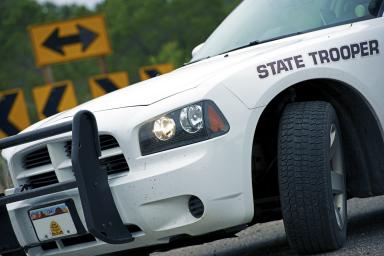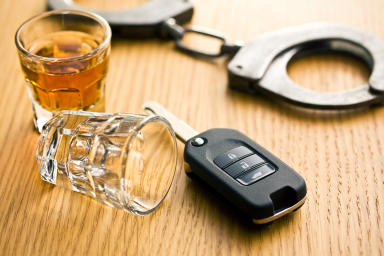Ohio DUI Laws

For the period 2019-2022, a staggering figure of almost 50,000 roadway crashes in Ohio were linked to impaired driving. Of these collisions, 2,497 resulted in fatalities, while 30,280 led to various degrees of injuries. These statistics accounted for over 50% of road crashes during that span. Additionally, the latest data from the Ohio State Patrol as of September 2023 already recorded 320 fatal crashes in the state relating to driving under the influence.
It can also be noted that while drunk driving cases have been on the decline in Ohio in recent years, there has been an alarming increase in incidents associated with marijuana. In fact, out of the OVI-related fatal crashes in the state by the end of 2022, 31% involved alcohol, while 38% involved the use of marijuana and other drugs.
To aid in addressing the pressing issue of impaired driving in Ohio, including helping the victims impacted by resulting accidents, this article will provide a comprehensive overview of the Buckeye State’s laws pertaining to driving under the influence.
General DUI/OVI Laws in Ohio
In Ohio, when a person is driving or operating a vehicle while intoxicated or under the influence, they can be charged with an OVI case. Unlike other states that typically use the more recognizable term, DUI, Ohio officially adopted OVI or Operating a Vehicle Impaired as the official term for these types of offenses. This development aims to assert that a person under the influence does not have to operate a vehicle for them to be considered guilty of this offense.
This means that an individual does not need to be outright driving to be considered as having physical control over a vehicle. They can just be inside a stationary car while impaired with alcohol or drugs, and they can be considered a threat not just to others but to their safety as well.
Adopting OVI as the official term also emphasizes that any transportation device, motorized or non-motorized, is considered a vehicle under Ohio state laws. Therefore, operating bicycles, scooters, and even golf carts while impaired may result in an OVI charge.
Ohio, along with other U.S. states, has an implied consent law. It requires all motorists who are lawfully arrested for DUI or OVI to submit to chemical testing — such as a breathalyzer, blood test, or urine test — to determine their blood alcohol content or the presence of drugs in their system.
Legal Limits in Ohio
Legal limits for alcohol content differ per state. The BAC limits for Ohio are as follows:
For drivers 21 and older: The legal BAC limit for adult drivers is 0.08%. If a driver's BAC exceeds 0.08%, they are considered legally impaired and can be arrested for OVI.
For drivers under 21: Ohio has a zero-tolerance policy for underage drinking and driving. Those under 21 may face charges for driving with any detectable level of alcohol in their system or with a BAC as low as 0.02%.
Commercial drivers: Drivers of commercial vehicles in Ohio are subject to a stricter BAC limit of 0.04%. This also includes school bus drivers.
For marijuana content, the drug is generally considered illegal in Ohio, but there are exceptions for patients who were prescribed medical cannabis. Still, though, strict limits are imposed on its use. As of 2022, you may be charged with OVI if the following levels of tetrahydrocannabinol are found in your system:
Per milliliter of blood: 2 or more nanograms of THC, 50 or more nanograms of marijuana metabolite, or 5 or more nanograms of metabolite in combination with alcohol and other drugs.
Per milliliter of urine: 10 or more nanograms of THC, 25 or more nanograms of marijuana metabolite, or 15 or more nanograms of metabolite in combination with alcohol and other drugs.
High-Tiered OVI
Unlike other states that have aggravated DUI, Ohio does not have a specific charge for this offense But it does have enhanced penalties for severe OVI violations. This is typically dubbed high-tiered OVI or “Super” OVI charges.
Aggravating circumstances that can result in more serious sanctions are the following:
High BAC - the person has a significantly high BAC at the time of the arrest, typically 0.17% or higher.
Previous OVI convictions - the person has subsequent OVI convictions, specifically within six years.
Refusal to submit to chemical testing - the person declines law enforcement’s request for chemical testing to determine their alcohol or drug levels. This can constitute a violation of the state’s implied consent law.
Endangering a child - the person is with a minor (someone under 18) at the time of the incident.
Serious bodily injury or death - the person’s actions led to serious bodily injury or death, which then escalates the charge to a felony case.
Any combination of the factors mentioned above can lead to harsher penalties.
OVI-Adjacent Laws in Ohio
Cycling Under the Influence
A bicycle is considered a vehicle in Ohio; thus, if you are caught under the influence while bicycling, you can be subject to the same legal ramifications as a motorized vehicle. Some of the consequences of an OVI charge for bicyclists are fines, license suspensions, and jail time. Ohio state law aims to emphasize that even if a cyclist only hurt themselves when they drive impaired, the ensuing incident could still have a profound effect on their loved ones and the community. Thus, heavy penalties await cyclists not abiding by OVI laws.
Boating Under the Influence
Similar to cycling, boating under the influence is also prohibited in the state. According to Ohio’s Revised Code, no person shall be in physical control of any boat, vessel, water ski, aquaplane, or other similar watercraft if they are considered under the influence as per the state’s legal limits. Ohio’s BAC for adults is 0.08%, but note that a BAC less than this amount can still be admissible in court along with other evidence that proves a case of boating under the influence.
Ohio’s Open Container Law
Ohio’s open container law refers to the state regulation that prohibits the possession of an opened container of beer or any other alcoholic beverage while operating a vehicle. This law applies not just to drivers but also to passengers. Even if riding in a stationary vehicle, a person can still violate this law if they are on a street, highway, or property accessible to the public.
The only exceptions to this law are:
If a person is a passenger in a chauffeured limousine.
If the said alcoholic beverage is a previously opened but resealed bottle of wine, stored in the car's trunk or behind the vehicle's last upright seat.
Underage DUI/OVI Laws in Ohio
Underage drinking and driving continues to be a rising concern all over the U.S. According to the National Highway Traffic Safety Administration, in 2018, the age group with the highest involvement in fatal roadway crashes was 16-20 years old. Along with the inexperience of young drivers, the other factors contributing to this number included nighttime driving, passenger interactions, not using seat belts, cell phone use, and driving under the influence.
In Ohio, among the 351 alcohol-impaired driving cases in 2019, 27 were drivers under 21 years old. Similar to other U.S. states, Ohio adopted the zero-tolerance policy as a measure to prevent underage drivers from consuming alcohol and other substances and then getting behind the wheel. Additionally, one of the highway safety plans of Ohio in 2022 to curb underage OVI was through a program called Underage Alcohol Sales Compliance Check. It focused on assessing the alcohol sales of establishments in counties with previously recorded high numbers of young drivers involved in fatal crashes.
What Are the Penalties for a DUI/OVI in Ohio?
Penalties for OVI in Ohio depend on several factors, including an individual’s BAC or THC levels, their number of OVI convictions in the last 10 years, and the circumstances surrounding the specific case. If you are charged with OVI, you may end up facing two types of penalties: administrative or criminal.
Criminal Penalties for an OVI Arrest
The unique thing about Ohio’s penalties against OVI is that even if you are a first-time offender, you can end up with jail time per the state’s revised code. The rest of the penalties are as follows:
Offenders with a 0.17% or higher BAC — along with other relevant aggravating factors — face increased penalties. Additionally, if you have been previously convicted of a felony OVI, all your succeeding charges will automatically become felony cases.
Administrative Penalties for an OVI Arrest
Even if an OVI arrest does not lead to criminal charges in court, Ohio’s Bureau of Motor Vehicles can still impose a license suspension on an offender. This happens if an individual refuses chemical testing — violating the state’s implied consent law — or agrees and then fails the said test.
Suspended drivers can petition the court to grant them a limited license. The license gives them driving privileges during the suspension period, but only with the installation of an ignition interlock device. This is a type of breathalyzer that prevents the car from starting when alcohol is detected in the driver’s system.
Here are the details of the license suspension for each offense and how long drivers can apply for a limited license:
Penalties for Underage OVI
An underage driver proven to be guilty of operating a vehicle under the influence can face up to 30 days in jail, a maximum fine of $250, and a license suspension of three months to two years.
Ohio’s Dram Shop Law
Ohio’s dram shop law imposes liability on restaurants or establishments that provide alcohol to individuals who subsequently cause injury or harm to others because of intoxication. An injured party can refer to this law to file a claim against the establishment if they sold an intoxicating beverage to a noticeably already intoxicated person or someone under the age of 21.
Liquor Liability Insurance
While not required by the state, liquor liability insurance can protect businesses against liabilities that come with selling intoxicating beverages. If sued by an injured party, this type of insurance helps cover medical bills, lost wages, and property damage, among others.
Social Host Liability
The dram shop law only applies to business establishments that are licensed to sell alcoholic drinks. People hosting a party or other social events are generally not responsible for injuries that their guests might cause. They can, however, still be held liable if they knowingly offered drinks to underage individuals who caused a vehicle accident afterward.
How Much Can Someone Sue for a Drunk Driving Injury in Ohio?
Similar to many other states, Ohio does not have a cap or limit on how much a person can receive as a result of a tort action, including OVI cases. This compensation can cover the full economic damages that a plaintiff incurred, such as their current and future medical expenses, lost wages due to the injury, and the cost of personal property damage, if any.
Meanwhile, the state imposes a limit on the amount a plaintiff can recover for non-economic damages. Non-economic damages are losses that are less tangible or are not easily seen, including pain and suffering. The cap for non-economic damages is $250,000 or three times the amount of economic damages awarded, whichever is greater. This is also subject to a maximum of $350,000 per plaintiff.
An exception to this cap is if the plaintiff suffered a catastrophic injury, such as a permanent disability or permanent physical deformity, making it impossible for them to perform daily life-sustaining activities.
Additionally, Ohio follows contributory negligence for the right to recover. This means that if a plaintiff is partially at fault for their injury, the compensation they can claim will be reduced accordingly. For example, if a plaintiff is awarded $100,000 as compensation but is found to be 30% liable for their losses, the total compensation amount will be decreased to $70,000. Note that if a plaintiff is proven to be more than 50% at fault for the situation, they will be barred from recovering any amount of compensation. In an established OVI case, plaintiffs do not have to prove the other party’s negligence because the act of driving under the influence is already considered negligent as per Ohio laws.
Ohio also limits the compensation a plaintiff can claim for punitive damages to twice the compensatory damages they receive. Punitive damages are a form of special compensation awarded on top of compensatory damages (economic and non-economic). This penalty aims to punish a wrongdoer if their actions are deemed grossly negligent, malicious, or intentional.
The Statute of Limitations in Ohio
Ohio imposes a two-year statute of limitations for most misdemeanor cases and extends it to six years for most felony cases. For OVI cases, an injured party must file a claim within these timeframes, starting from the date of the injury. Filing a claim after these deadlines will likely result in the court dismissing it.
Some exceptions to the statute of limitations imposed by Ohio include the following:
If an injured person was a minor at the time of the incident, they can file a lawsuit within two years after turning 18.
If the injured party is a person with a mental disability, they can file a lawsuit within two years after their disability is healed.
If the liable person is missing, concealed, or absent, the injured party can file a claim after they are found.
However, these exceptional cases are rare, and it is not advisable to rely on them for your case. It is best to adhere to the state’s general statute of limitations to avoid the risk of having your case dismissed.
This time limit, along with many other contributing factors, typically compels victims of impaired drivers to seek professional help from attorneys with proven expertise in OVI lawsuits.
Resources for OVI Defendants and Folks Injured by an Impaired Driver in Ohio
Mothers Against Drunk Driving Ohio
MADD in Ohio is the state chapter of a national non-profit organization dedicated to combating drunk driving, supporting victims of impaired driving crashes, and advocating for stronger laws to create a future with No More Victims. Some of the services MADD offers are victim compensation, emotional support, and guidance through the criminal and civil justice systems, among others. You can contact MADD’s 24-hour victim helpline at 1-877-623-3435.
Ohio Attorney General’s Office - Crime Victim Services
Crime Victim Services is dedicated to providing support to Ohioans by offering financial assistance that can cover expenses such as medical bills, lost wages, counseling costs, and others. Eligible crime victims, including those badly impacted by impaired driving, can potentially receive up to $50,000 in compensation from this program. You can contact the Crime Victim Services section at 800-582-2877.
Ohio Crime Victim Justice Center
OCVJC is a non-profit organization that provides free legal assistance to victims of various crimes, including those affected by impaired driving. Some of the services it offers include representing victims in criminal court, educating them on their specific rights, and investigating if their rights are violated. Its office can be reached at 614-848-8500.
Expertise.com StaffAuthor
Step into the world of Expertise.com, your go-to hub for credible insights. We don't take accuracy lightly around here. Our squad of expert reviewers, each a maestro in their field, has given the green light to every single article you'll find. From rigorous fact-checking to meticulous evaluations of service providers, we've got it all covered. So feel free to dive in and explore. The information you'll uncover has been stamped with the seal of approval by our top-notch experts.




